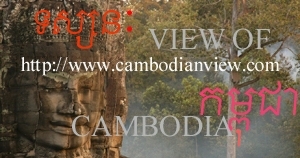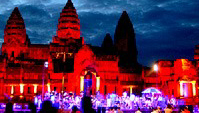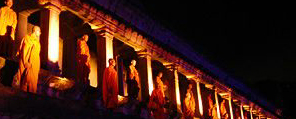 |
|
HOME | DEPARTMENT | DHAMMA AUDIO | PHOTO ALBUM | ACADEMIC WRITTINGS | BUDDHIST SCHOOL | NEWS | KHMER LINKS KCBCC, 7011 Ogden Road., S.E., Alberta, Canada
T2C 1B5 Copyrights @ April, 2003-2013
Started: Wed / 13 / August / 2547 / 2003 |
 |
 |
 |
|
HOME
| DEPARTMENT
| DHAMMA
AUDIO
| PHOTO
ALBUM
| ACADEMIC
WRITTINGS
| BUDDHIST
SCHOOL
| NEWS
|
LINKS|
|
HISTORY OF BUDDHISM IN KINGDOM OF CAMBODIA
(PLEASE, READ IN KHMER VERSION)
BRIEF HISTORY OF BUDDHISM IN THE KINGDOM OF CAMBODIA
In the year of 238 B.C (before Christ), Emperor Asoka King sent two learned Bhikkhu monks named Sona Thera and Utara Thera to propagate Buddhism in Suwanaphumi or Southeast Asia of present time. From that time Buddhism has flourished through out the land of Suwanaphumi or golden land. We are able to trace back through various ancient kingdoms such as Funan Kingdom (first state of present Cambodia) had been claimed about the advantage of Buddhism in this capital city. Among the kings of Funan dynasty, Kaundinya Jayavarman (478-514 AD) sent a missionary to China under the leadership of a Buddhist monk named Nagasena from India. During the reign of the same Chinese emperor, two learned Khmer monks named Sanghapala Thera and Mantra Thera of Funan went to China. At this early years of the sixth century AD, the two learned Cambodian Bhikkhu monks taught Buddhism and meditation to the emperor of China. Bhikkhu Sanghapala had translated an important Buddhist scripture Vimutti Magga(the Way of Freedom) which it is believed older than Visutthi Magga (the Way of Purity) written by Buddhagosacara. Now this Chinese manuscript has been translated into different language by many Buddhist countries.
King Rudravarman (514-539 AD) is said to have claimed that in his country
there was a long Hair Relic of Lord Buddha for his people to worship. The
Tharavada with Sanskrit language flourished in Funan in the fifth and earlier
part of the sixth centuries AD. Around seventh century AD, the popular usage
of Pali language in southern region manifested the strong appearance of Theravada
Buddhism in Cambodia.
The great emperor, Yasovarman (889-900 AD) established a Saugatasrama and
elaborated regulations for the guidance of this asrama or hermitage, at the
time, Buddhism, Brahmanism (both Visnuism and Vaisnavism) flourished in Cambodia.
During the reign of Jayavarman V (968-1001 AD), the successor of Rajendravarman
II, Mahayana Buddhism importantly advanced. The king supported Buddhist practices
and invoked the three forms of existence of the Buddha. In this way, up to
the tenth century AD, Mahayana Buddhism became substantially prominent.
Pramakramabahu I, the king of Sri Lanka, is said to have sent a princess as a bride probably for Jayavarman VII, son of Dharnindravarman II (1150-1160 AD), who was the crown prince. King Jayavarman VII (1181-1220 AD) was a devout Buddhist and received posthumous title of Mahaparamasaugata. The king patronized Mahayana Buddhism, his records expressed beautifully the typical Buddhist view of life, particularly the conduct of charity and compassion towards the whole universe. Taprohm Inscription of his reign informed that there were 798 temples and 102 hospitals in the whole kingdom, and all of them were patronized by the king. One of the monks who returned to Burma with Capata Bhikkhu was Tamalinda Mahathera, who is believed the son of the Cambodian Emperor Jayavarman VII. Under the influx of Sihala School Buddhism; his administrative prestige retreated, his temporal power crumbled away, and the god-king cult was weakened. Theravada Buddhism had become the predominant school of the people of Angkor at the end of Jayavarman VII 's reign.
The second half of the twelfth century AD, Sri Lanka's fame as the fountain-head of Theravada Buddhism reached the Buddhist countries of Southeast Asia. The knowledge of Sinhala Buddhism was so wide-spread and the Sinhala monks were so well-known to the contemporary Buddhist world. At this time, a Cambodian prince is said to have visited Sri Lanka to study Sinhala Buddhism under the guidance of the Sinhala Mahatheras. Buddhism continued to flourish in Kambuja in the thirteenth century AD and became the dominant school in the Kingdom. Thereafter, Theravada became the main school of Buddhism. The change was likely due to the influence of the Thais of Thailand, who were devout Buddhists and had conquered a large part of Cambodia land. Under the influence of the Thais, Sinhala Buddhism was also introduced in Cambodia. As time changed, the Brahmanical gods like the Angkorean Period were replaced by Buddhist status. Gradually, Buddhism became the dominant school in Kambuja and today there is hardly seeing any trace of the Brahmanical religion in the country, as said it had mixed like the people folk belief.
The Jinakalamali gives an account of the cultural connection between Cambodia and Sri Lanka in the fifteenth century. It states that 1967 years after the Mahaparanibbana of Lord Buddha, eight monks headed by Mahananasiddhi from Cambodia with 25 monks from Nabbispura of Luburi went to Sri Lanka to receive the Upasampada ordination under the preceptor of the Sihalese Mahatheras. Buddhism continued to flourish in Cambodia in the sixteenth century AD. King Ang Chan (1516-1566 AD), a bloodline of king Dhammaraja, was a devout Buddhist. He built pagodas in his capital and many Buddhist shrines in different parts of the Kingdom in order to engage Buddhism. King Satha (1576-1594 AD), son and successor of Barom Reachea, restored the great third floor of Angkor Wat (in the past was erected and dedicated to the god of Visnu), which was built by King Suriyavarman II (113-1150 AD), had become a Buddhist shrine or Buddhist Temple by the sixteenth century AD. During the seventeenth and eighteenth centuries, Thailand's interference in Cambodia's politics restored its past influence to to the Kingdom. Though Thailand interfered Cambodia's politics and took tremendous advantage over Cambodia, the Thai kings and their Buddhist influence made a distribution to Buddhism in Cambodia.
Under the occupation of French (1863-1954 AD), Buddhism in Cambodia progressed under the struggle of Bhikkhu monks within temples. France had undertaken minimal educational plan for Cambodian people especially to study at higher level. Many Cambodians who wished to study higher education, they must travel to Vietnam. In Cambodia, France allowed Cambodian to study in the purpose to work as the translator for them. Bhikkhu monks are considered enemy by French colonist. While French try to change the stream of Khmer literature and culture, Khmer Bhikkhu monks contradictorily struggled to maintain and advance them within the temples. Temples were central for basic and higher education of local population.
After getting freedom from France, Cambodia Buddhism grew up again under the patronage of King Norodom Sihanu. His Majesty the King encouraged the assembly to include Buddhism as the state religion. In that time, Cambodia had many Buddhist scholars such as Somdech Choun Nat, Somdech Hout Tat, Pang Khat and Kiev Chom etc as the active leaders of developing the concept of engaged and applied Buddhism in Cambodia.
In 1975 AD, when the communists took control of Cambodia, they targeted to eliminate Buddhism and they nearly succeeded. By the time of the Vietnamese invasion in 1979 AD, major monk and religious intellectuals were either murdered or driven into exile, and major Buddhist temples and libraries were destroyed.
Today, Cambodia Buddhism is struggling to re-establish itself in the meantime of the lacking Buddhist scholars and learned leaders as well as the continuing political stagnant is making the task more challenging.
However, the author optimistically believe that Buddhism in Cambodia would gradually heighten up to its glory again. Nowadays, the administrative of religion is under the ministry of Religion and Cult Affair. We have the Buddhist institute for researching Buddhist scripture. And the constitution of Kingdom of Cambodia have subscribed Buddhism as the state religion within the article 43 stating that:
"Khmer citizens of either sex shall have the right to freedom of belief. Freedom of religious belief and worship shall be guaranteed by state on the condition of such freedom does not affect other religious belief or violate public order and security. Buddhism shall be the State Religion"
The government support the Buddhikaseksa education of Bhikkhu monks as has reaffirmed in the constitution in article 68 stating that:
"the state shall provide primary and secondary education to all citizens in public school. The state shall disseminate and develop the Pali school and the Buddhist Institute"
This article formerly written by BHIKKHU SOPHAN SENG (VODANO) and it has been reviewed and edited by Mr. Sophan Seng on March 3, 2013
Contact author: info@sophanseng.info
(All rights reserved)